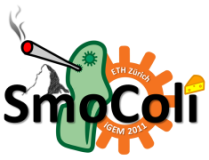Team:ETH Zurich/Biology/Safety
From 2011.igem.org
Question 1
Would any of your project ideas raise safety issues in terms of:
- Risks to the safety and health of team members or others in the lab
No, the use of certain toxic or carcinogenic chemicals is indispensable in biology lab work. Acetaldehyde is used to turn off our expression system and is a toxic and carcinogenic substance. Work with acetaldehyde is done in a cold room at 4 degrees after cooling down the substance and all equipment to -20 degrees to prevent vaporization. Handling with other volatile chemicals is performed under a hood to avoid inhalation.
E. coli strains DH5-alpha and JM101 are used for our experiments. Both strains are neither pathogenic nor infective nor toxic. Likewise our included constructs do not cause any risk. All lab work is carried out in a S1 lab with conventional safety standards. Normal safety precautions such as wearing gloves, glasses and a lab coat to protect ourselves are implemented. No bacteria are released into the environment. All material contaminated with bacteria is autoclaved at 120°C. Harmful chemicals are collected and disposed of, separately.
- Risks to the safety and health of the general public and Environmental quality if released by design or accident
Our system is isolated and has no direct contact with the environment outside the lab. Thus it should not pose a risk to public or environment by design. Nevertheless there is always a risk of releasing genetically modified organisms into the environment, especially in case of an accident. Transfer of genetic material between the GMOs and other bacteria can always take place.
- Risks to security through malicious misuse by individuals, groups or states?
The system we designed is composed of a sensor which gives a certain output. In our design fluorescent proteins (gfp and mcherry)act as outputs of the system. These proteins do not cause any security issues. Still the output of the sensor could be changed in order to cause damage to the environment and humans. Thus one can never exclude the malicious misuse of a biological sensor.
Question 2
Do any of the new BioBrick parts (or devices) that you made this year raise any safety issues? If yes,
- did you document these issues in the Registry?
- how did you manage to handle the safety issue?
- How could other teams learn from your experience?
No, the new BioBrick parts we are making do not raise any safety issues.
Question 3
Under what biosafety provisions will / do you operate?
a. Does your institution have its own biosafety rules and if so what are they? Provide a link to them online if possible.
b. Does your institution have an Institutional Biosafety Committee or equivalent group? If yes, have you discussed your project with them? Describe any concerns or changes that were made based on this review.
The security consultant of the D-BSSE department of the ETH stated that there is no general security issue with our project and forwarded us to Professor Sven Panke, for getting his opinion on the safety of our biological system. He did not find any reason for concern in our design.
c. Will / did you receive any biosafety and/or lab training before beginning your project? If so, describe this training.
All people working in the lab had a special training on chemical and biological safety in the lab and a fire prevention course in previous practical courses. Also everyone attended lectures on lab safety. But there was no special biosaftey or lab training for iGEM.
d. Does your country have national biosafety regulations or guidelines? If so, provide a link to them online if possible.
In particular for our project we consulted the "Freisetzungsverordnung" (FrSV) and the "Einschliessungsverordnung" (ESV) in the Swiss Legislature and checked that our project does not raise any safety issues.
Question 4
Do you have any other ideas how to deal with safety issues that could be useful for future iGEM competitions? How could parts, devices and systems be made even safer through biosafety engineering?
The release of genetically modified organisms (GMOs) to the environment has to be avoided under all circumstances. Thus strains have to be engineered in an appropriate way. Further lab practices need to be optimized and adapted to recent progress done in science. The generation of knowledge and the responsible and sustainable application of it are crucial for the safety of biologically engineered systems.
Safety considerations in Switzerland and at ETH Zurich
References
[2] Swiss Legal Bases Biotechnology
[3] Swiss Legislature: Release Ordinance, RO / Freisetzungsverordnung, FrSV
[4] Swiss Legislature: Einschliessungsverordnung, ESV (german / french / italian only)
[5] Swiss Expert Committee for Biosafety SECB
[6] SSHE: Safety, Security, Health and the Environment @ ETH
 "
"

